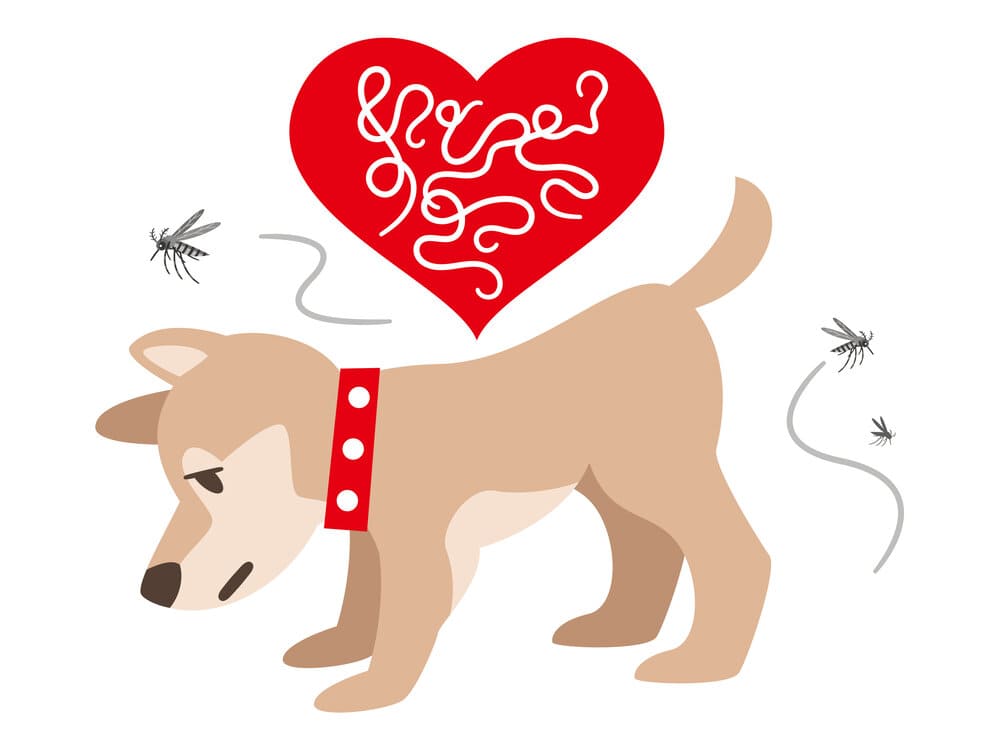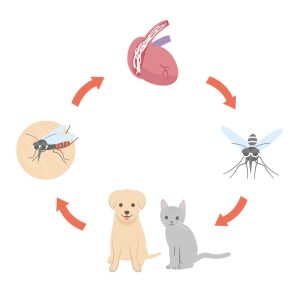Most pet owners understand the importance of preventative medication and the crucial role it plays in managing heartworm disease. However, things can get a little “testy” when we begin to discuss the equal importance of yearly heartworm testing for your dog. It seems counterintuitive that we need to “test” a pet for a disease that we are supposedly “preventing” with medication given per recommendations of the manufacturer.
Why do we need to do this? Isn’t testing just a waste of time, a waste of money? What gives? We need to test because the reality of the world we live in is this: people forget, people get busy, even the most conscientious owner may be late in giving preventative medications. To understand why testing is so important one needs to have a basic knowledge of the life cycle of the heartworm.
 Cycle of Infection
Cycle of Infection
The heartworm disease cycle begins when a mosquito takes a blood meal from an infected dog. The blood of an infected dog contains small larvae (microfilaria) that are taken into the mosquito and go through a 2-week maturation process inside the mosquito. The mature larvae are then referred to as infective larvae. When the mosquito takes another blood meal, possibly from a non-infected dog, it injects these infective larvae into the tissue of the dog.
These larvae continue to grow and mature in the tissues for approximately 2 months before finding their way into the bloodstream and migrating to the lungs and heart. The young adults take 4-5 months to continue their growth and journey to the heart and blood vessels within the lungs. Once in the heart and lungs, the adult worms can live 5-7 years in a dog, reproducing during that time. Adult heartworms in cats have a more difficult time. If they happen to mature to adulthood they may only live 2-3 years and mature worms rarely reproduce in cats.
The Importance of Timing
The most common test for heartworm disease is an antigen test that is easily run in any small animal office. This test requires only a few drops of blood to obtain results. The test is considered an antigen test. It measures the presence of a specific protein (antigen) released into the bloodstream by adult female worms. It usually reliably detects heartworm disease if there are at least 1-2 female worms present. An additional test, the microfilaria test, tests for the presence of circulating immature larvae (microfilaria) in the blood and again, requires only a small amount of blood to run. Identifying the presence of microfilaria will help you determine if your dog could infect other dogs.
As the heartworm test detects a protein released from adult female worms, your pet may test negative if the test is not timed correctly. As you learned in the prior section, it can take 6-7 months for immature larvae to become adults. Therefore, you must test a minimum of 6-7 months after infection or you might obtain a negative result on an antigen test.
Puppies should start heartworm prevention at 8 weeks of age and continue monthly and year-round for life. A puppy’s first heartworm test should be timed around 7 months of age then repeated 6 months later. The puppy should then be tested yearly. Adult dogs that have never been on heartworm preventatives should be tested before starting, 6-7 months later, 12 months later, and then yearly. If you forget to give your pet preventative for one or more months retesting 6-7 months after the last missed dose is highly recommended.
 Why is testing so important?
Why is testing so important?
Heartworm preventatives are highly effective but we cannot say they are 100% effective at preventing heartworm disease. Some evidence of resistance to certain anthelmintics has been identified in the heartworm population. This isn’t cause for alarm as long as the medications are given monthly but could become an issue in the future. Human error in the administration of the medication could lead to missed or late doses, putting your pet at risk of infection. Your pet could throw up or spit up the medication and the list of reasons for missing a dose or two goes on. The importance of appropriate yearly testing and correctly timed tests after missed doses cannot be over-emphasized.
Heartworm testing in cats is a different story. As the antigen test only identifies the presence of female worms, your cat may test negative if infected with male worms. The microfilaria test is often useless in cats as any surviving adult worms in cats are usually not healthy enough to reproduce and produce microfilaria.
My dog is heartworm positive, what do we do?
If your dog tests positive, a confirmatory antigen test is sent to a certified laboratory. If that test is positive, treatment is instituted. There is only one approved treatment for heartworm in dogs, a medication called melarsomine. There is no approved treatment for cats. Although melarsomine is safe and effective, side effects are common. The treatment for heartworm disease in dogs is expensive, somewhat painful, and time-consuming. Cats simply cannot receive treatment to kill heartworms and all their symptoms must be treated symptomatically making the disease difficult and life-threatening in cats. As Benjamin Franklin once said,” An ounce of prevention is worth a pound of cure.” This statement cannot be more true, especially in regards to heartworm disease in pets.
For more information on heartworm disease, the staff of Longwood Veterinary Center is always here to help answer questions. However, the American Heartworm Society provides an incomparable resource for pet owners. For a wealth of up to date and important information visit their website here: www.heartwormsociety.org
